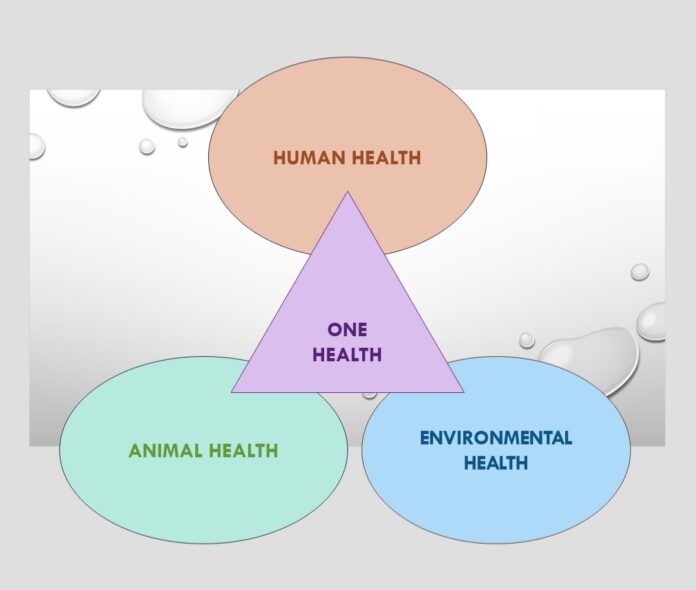One World- One Health: Prevent Zoonoses
Bithika Halder *
*-Veterinary Officer, Mobile Veterinary Clinic, Lalgola Block, Murshidabad, West Bengal (India). Email: bithikahalder2018@gmail.com
Background
The new concept, “One World, One Health,” is based on the understanding that humans, animals, and the environment are inter- linked, indicating that the world has suddenly realized the interrelation between ecology, animal diseases, and public health, striving to restore and maintain harmony and synergy. The “One World, One Health” (OWOH) concept first emerged at a 2004 symposium organised by the Wildlife Conservation Society in New York. The resulting “Manhattan Principles” listed 12 recommendations for establishing a more holistic approach to prevent epidemic/epizootic disease and for maintaining ecosystem integrity and biodiversity. These ideas were picked up at the 2007 Delhi International Ministerial Conference on Avian and Pandemic Influenza, at which a road map was developed encouraging governments to build links between human and animal health systems and invest in capacity to prevent and control infectious diseases in animals, both internally and with neighbour nations. These objectives sat well with the 2005 revision of the 1969 International Health Regulations, which signed an important shift in the international governance of public health issues, with a ceding of national jurisdiction, at least in theory, in the face of a global threat. In October 2008, four specialised agencies, the FAO, OIE, WHO and UNICEF, together with the World Bank and the UN System Influenza Coordinator (UNSIC) presented a consultation document, ‘A Strategic Framework for Reducing Risks of Infectious Diseases at the Animal-Human-Ecosystems Interface’ in response to the New Delhi recommendations. It built on lessons learned from the response to the H5N1 panzootic, inducing enhanced disease intelligence, surveillance and emergency response systems at national, regional and international levels, improved public and animal health services, and effective national communication strategies.
What is zoonoses:
Zoonosis is an infectious disease transmitted between species from animals to humans or vice- versa can be caused by bacteria, viruses, parasites, and fungi. It can be transmitted through direct contact with infected animals, consumption of contaminated food or water, or through vectors such as ticks and mosquitoes. Approximately 60% of known infectious diseases in humans and 75% of emerging infectious diseases are zoonotic in nature. Some widely known zoonotic diseases include rabies, Ebola, avian influenza (bird flu), Zika virus, Lyme disease, and COVID-19. Zoonoses can have a significant impact on human health, causing illnesses ranging from mild to severe and even leading to death. They can also have economic implications due to healthcare costs, loss of productivity, and trade restrictions. Companion animals, such as dogs and cats, can act as reservoirs for zoonotic diseases and transmit them to humans. Livestock, including poultry, swine, and cattle, can also be sources of zoonotic infections. Wildlife plays a key role in the transmission of zoonoses. Human intrusion into natural habitats and increased contact with wildlife can facilitate the flow over of diseases from animals to humans.
What is one health (OH) approach:
The interconnectedness between living beings, including humans, animals and pathogens, sharing the same environment, should be considered as a unique dynamic system, in which the health of each is completely interlinked and dependent with the others. Nowadays, a new integrated One Health approach is reflecting this interdependence with a holistic view to the ecological system. The One Health approach can be defined as a collaborative and a multidisciplinary effort at local, national and global level to provide an optimal healthy status for humans, animals and environment. Strictly related to the One Health concept is to be considered the control of infectious diseases, which have influenced the course of human history.
Prevention of zoonoses:
Prevention and control of zoonotic diseases require a One Health approach, which recognizes the interconnection of human health, animal health, and the environment. Collaboration among health sectors, veterinary services, environmental agencies, and other stakeholders is essential. Proper hygiene practices, such as regular hand washing, safe food handling and preparation, and appropriate waste management, can help reduce the risk of zoonotic infections. Vaccination plays a crucial role in preventing some zoonotic diseases. Vaccinating both humans and animals can help control the spread of diseases and protect populations. On World Zoonoses Day, various organisations, government agencies, and non-governmental organisations (NGOs) organize awareness campaigns, conferences, workshops, and other events to educate the public about zoonotic diseases. These initiatives emphasise the need for improved surveillance, early detection, rapid response, and effective control measures to prevent the spread of zoonotic diseases and protect both human and animal populations.


